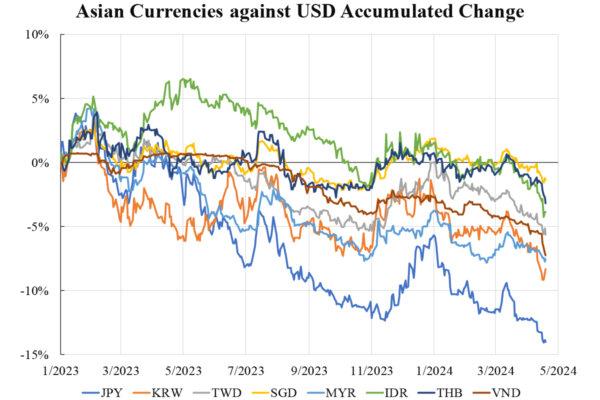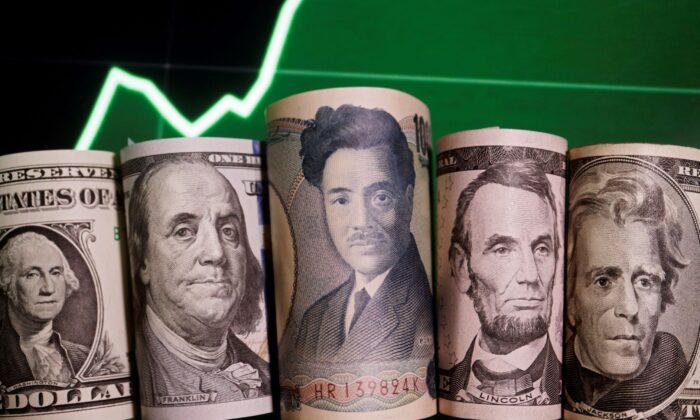Recently, Asian currencies have experienced quite a sharp depreciation. This was led by the Japanese Yen (JPY) depreciation against the backdrop of a strong U.S. dollar. JPY has been the focus because it is the only major global currency with almost zero interest rates. Under such a “rate disadvantage,” JPY depreciation has been well anticipated. The depreciation seemed to infect other Asian currencies as the dollar index (DXY) edged to above 106. Since China, the leading Asian country is now in deep trouble, the market is speculating about another Asian crisis.
Let us first check how severe the Asian currency’s depreciation is. The accompanying chart shows the eight major Asian currencies, excluding China and Hong Kong, where these two are highly manipulated. The displayed lines show the percentage against U.S. dollar accumulated from the beginning of 2023. Since accumulation is sensitive to the initial date, the period (from 2023 to now) is carefully chosen such that DXY has been staying within a horizontal channel, roughly from 100 to 107. This depicts the Asian currency’s performance when the dollar is stable.

Apart from the JPY, other Asia currencies experienced a first round of depreciation in Spring 2023 and then remained stable until Spring 2024. In the recent month, a potential new depreciation trend kickstarted, but this is yet to be confirmed. In terms of magnitudes, these are only a few percentage points of depreciation, which may be regarded as normal market movement rather than any crisis. Although the evidence of Asian crisis II is unclear, we can infer the likelihood from relative economic strengths between the East and West as this drives capital flow.
Asia’s local demand has previously been dominated by China, but China’s influence is now much weaker. Thus, Asia’s current main driver is mostly export business; whether Western import demand turns weak or the production line is pulled back becomes the key to whether a new crisis is likely. The pull-back factor is less obvious given lots of production lines were moved from China to other Asian countries (more than back to the West). Western demand is not very weak as inflation is much lower than the previous peak level. On the surface, a crisis is not too likely.
Having said that, the outlook is certainly not as strong as projected by optimists like the IMF. The big bust of China may ultimately drag down the region as the situation is bad. Another potential threat is when global (mainly U.S.) inflation edges higher, requiring further interest rate hikes, the impact on the secondary industry (production) will be larger than tertiary (services) because the former employs higher leverage (which is more sensitive to rate hike) in massive production, not to mention geopolitical tension could further boost costs higher.
Another threat is production easing, which would drive capital outflow and currency depreciation. This would lead to balance sheet misbalancing where U.S. dollar liabilities rise, while local currency assets fall. Such currency mismatch would lead to illiquidity or even insolvency. Yet current indicators suggest even if all these happen, the extent should be lower than in the late 1990s.







